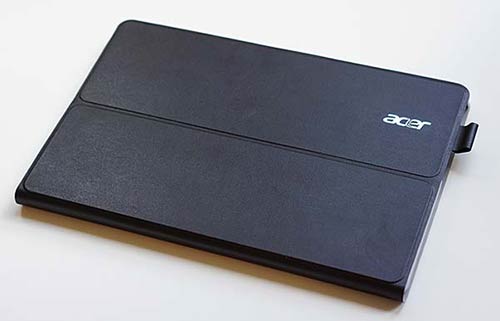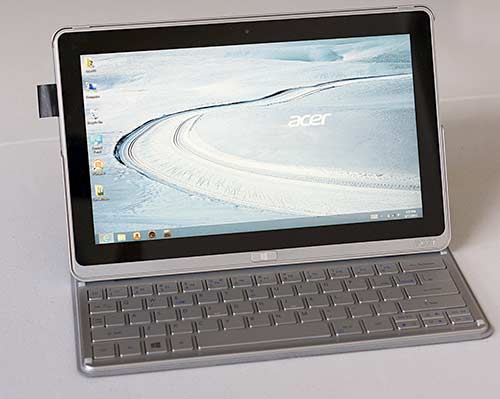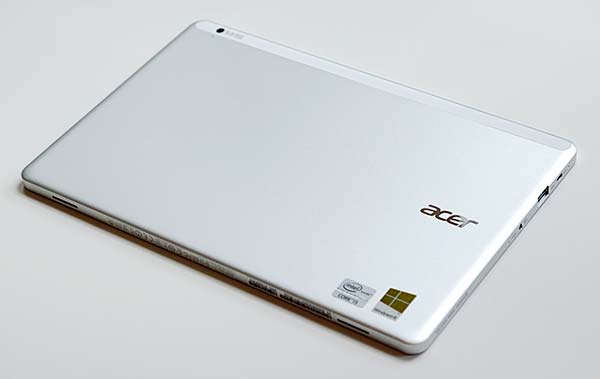Acer Aspire P3 Review
07:00
Acer's trying to confuse us: they call the new Acer Aspire P3 an Ultrabook when it's actually a Windows 8 tablet with a keyboard case. In fact, they've switched from the Iconia tablet branding to the Aspire notebook brand, yet the Aspire P3 is the near clone of the Acer Iconia W700 11.6" Windows 8 tablet. The Aspire P3 runs Windows 8 64 bit on a 1.5GHz Intel Core i5-3339Y dual core CPU and it has a 1366 x 768 IPS multi-touch display. Inside you'll find 4 gigs of DDR3 RAM and a 120 gig SSD drive. Like Microsoft Surface Pro and Acer's own W700, it has Ultrabook internals, so it can easily handle MS Office, web, streaming video and photo editing.





Acer includes a keyboard case that's reminiscent of the more robust models available for the iPad. It's a Bluetooth keyboard attached to a black faux leather case that's attractive and sufficiently protective. The tablet snaps into the back section of the case but there's no release lever, so it takes a bit of fiddling and prying to get it out, not unlike hard plastic smartphone cases that wrap around the sides. The tablet and case together weigh 3 pounds, and the tablet alone weighs 1.74 pounds, which is a bit lighter than the 2.1 pound Acer W700.
Our 1.5GHz Core i5 model with 4 gigs of RAM and the 120 gig SSD lists for $899. That's just $100 less than the more capable Acer Iconia W700 that has a full HD display, a faster CPU and longer battery life. That makes it hard to recommend the Aspire P3 over Acer's W700.
Design and Ergonomics
The tablet has an aluminum casing and it's hard to tell apart from the W700 (hint, it's a hair thinner). It's a clean, straight-sided design and despite the slim design and metal casing it doesn't get unbearably hot. It has a single USB 3.0 port, 3.5mm audio and micro HDMI but no SD card slot. It has a front 720p webcam and a passable rear 5MP camera with no flash. The tablet has stereo speakers that are decently loud for an 11" tablet, and they don't distort terribly at high volumes. The speakers fire from the bottom edge (when held in landscape mode).

The Aspire doesn't look in the least bit budget, but its design is a bit plain; it lacks the stylish flare of the Acer Aspire R7 convertible and Acer Aspire S7 Ultrabook models (we're thinking of the 11.6" aluminum S7, but the glass-clad S7 is gorgeous too). It's rigid and feels well made and we expect it to hold up as well as our Iconia W700 has. The fan is quiet to silent when working in MS Word or Excel, and it's sometimes audible but by no means loud when playing HD video.
Keyboard Case
Acer has a few slick tricks: though this is a Bluetooth keyboard permanently mounted into a case much like iPad and Android third party keyboard cases, it has some smarts: when the tablet is turned off and you open the case, the keyboard and tablet turn on, much like Acer's Ultrabooks that turn on when you raise the lid. The keyboard has a power button just in case that magic trick doesn't work, though it always turned on automatically for us. The keyboard doesn't use disposable batteries, rather it charges via a micro USB to USB cable when needed.

There's no trackpad or backlighting here, but the keyboard does have fairly roomy keys and good tactile feel. Key travel is comparable to Ultrabook keyboards, which is pretty good for a keyboard case product. I had no problems typing this review on the P3's keyboard, and the only creature comfort I missed was backlighting. The embedded arrow pad has Fn controls for display brightness and volume and the only layout oddity is that the caps lock key shares real estate with the tilde key that would normally be located under the escape key. In laptop position, the tablet rests in a ridge on the keyboard deck and it's steady enough for use on a desk or non-fidgety knees. You can't adjust the display angle, but the IPS panel's viewing angles are quite wide so won't complain too loudly.

Performance and Horsepower
This is one of the first Intel Y series CPUs we've tested in a product. This is a late third generation Ivy Bridge CPU meant to bridge the gap with Haswell in terms of power consumption. It's intended particularly for tablets and it runs at 13W max vs. 17 watts for ULV Ultrabook CPUs like that used in the Acer W700, Asus Zenbook Prime UX31A Touch and Acer Aspire S7. It's designed to putter along at an even more power frugal 7W under light loads. As you might expect, performance is thus slightly lower, and our model scored 3954 on PCMark 7 vs. 4357 on our 1.7GHz Intel Core i5-3317U Iconia W700. Still, it's responsive enough and is nearly 4 times faster than today's Intel Atom Windows 8 tablets. That means you won't suffer painful lag when running Windows Updates or multitasking. It's perfectly capable of handling standard productivity tasks, playing HD video and software development if you don't mind waiting a bit longer for compiles. It's not a great gaming machine if 3D games are your thing, but it's fine for casual games, Windows Store games and older 3D titles. Like nearly all Windows tablets on the market, it has Intel HD 4000 integrated graphics. We noticed our Iconia W700 sometimes was overzealous with thermal throttling and that is less of a problem with the lower power and cooler Y series CPU in the P3.
The tablet has 4 gigs of DDR3 RAM and a 120 gig mSATA SSD (ours was made by Intel). The SSD showed good read speeds and acceptable but not stellar write speeds. After installing Windows updates, our machine had 75 gigs of available space.
Display
Acer understands the importance of a good display on their high line products, and though the Aspire P3 is a step down from the 1920 x 1080 Iconia W700, it nonetheless has a very sharp and bright IPS display that's easy on the eyes. Honestly, we don't lament the lack of a full HD display on an 11.6" tablet since desktop icons and text tend to be tiny unless you apply scaling, which can degrade text quality (Windows 8.1 will improve this somewhat). The 1366 x 768 display has wide viewing angles and it measured 422 nits of brightness, which is well ahead of the pack. Contrast is likewise high at 900:1 and black levels are decent. Though graphics professionals might wish for better, the Aspire P3 achieves a respectable 70% of sRGB, and an OK 54% of Adobe RGB. That translates into pleasing looking photos, colorful movies and text that's sharp enough to suit most eyes.
Sorry, there's no active digitizer option or digital pen, so this isn't the tablet for artists, avid note takers or vertical workers who require precise pen input or pressure sensitivity. You can use a capacitive stylus, but you won't get palm rejection or a high degree of accuracy.
Wireless
The Aspire P3 has Bluetooth 4.0 (you knew it has Bluetooth since it ships with a Bluetooth keyboard) and dual band Atheros 802.11b/g/n WiFi. Wireless worked reliably in our tests and range was equivalent to notebooks: we had to move beyond 30 feet from our 802.11n 5GHz router to see any speed reductions.
Battery Life
Acer says to expect 5 hours of battery life, and that's exactly what we got with brightness at a very adequate 50% and both WiFi and Bluetooth on. In our tests we used the tablet in a mix of MS Office, web browsing, email and streaming an HD episode of Downton Abbey via Amazon Prime. That's not bad, though the Iconia W700 averaged 6 hours in the same tests. The compact white charger is the same one included with the Acer Aspire S7 and Acer Iconia W700


0 comments